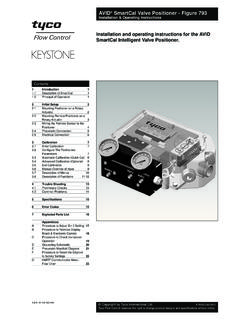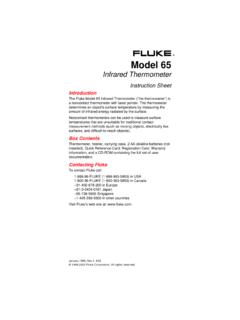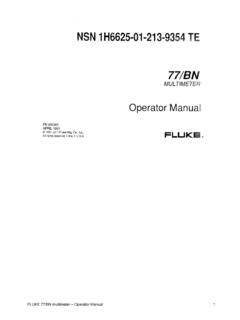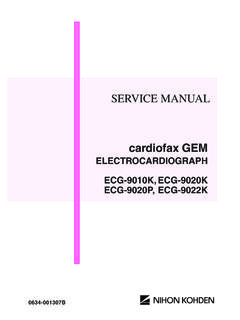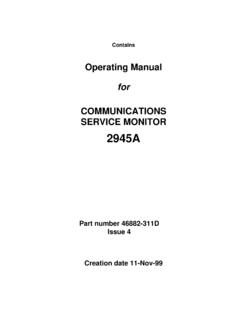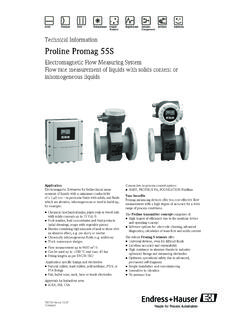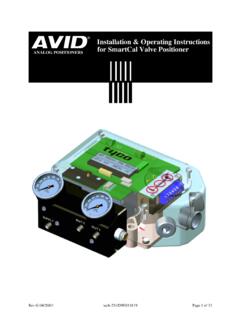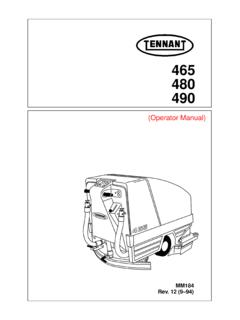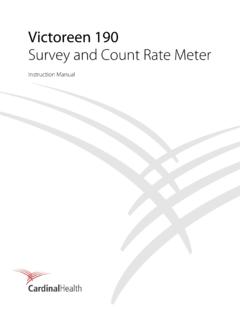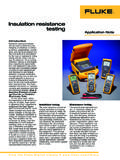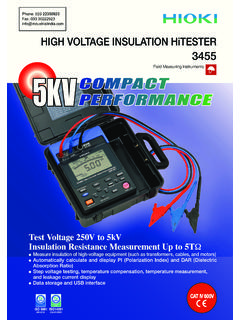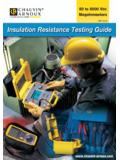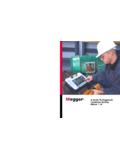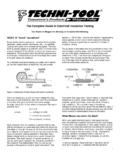Transcription of BM80/2 Series Multi-Voltage Insulation and …
1 MBM80/2 SeriesMulti- voltage Insulation and continuity TesterUser GuideGuide de l utilisateurGebrauchsanleitungGu a del usuarioContentsSafety Warnings2 Notes3 General Description4 - 5 OperationTesting is automatically inhibited testing on high energy systems 6 Auto-shut Off6 Insulation Tests (M )7 Polarization Index Testing7 continuity Testing ( )8 continuity Bleeper ( )8 Zeroing of Test Lead Resistance 8 Resistance Tests (k )9 voltage Tests (V)9 Live Circuit Warning9 Battery Check ( )10 Battery Replacement10 Fuse Checking and Replacement10 Application NotesPreventive Maintenance11 Insulation Testing Concepts 12-13 Specification14-17 Typical Terminal voltage Characteristics18 Accessories19 Repair and Warranty20 Mode d emploi22 - 43 Betriebsanleitung44 - 65 Instrucionnes de Uso66 - 8712 SAFETY WARNINGS Safety Warningsand Precautionsmust be read and understood beforethe instrument is used.
2 They must be observed during use. The circuit under test must be de-energized and isolated beforeconnections are made except for voltage measurement. Circuit connections must notbe touched during a test. After Insulation tests, capacitive circuits mustbe allowed to dischargebeforedisconnecting the test leads. The Live Circuit Warning and Automatic Discharge are additional safetyfeatures and should notbe regarded as a substitute for normal safeworking practice. Replacement fuses mustbe of the correct type and rating. Test leads, including crocodile clips, must be in good order, clean andhave no broken or cracked Insulation . Safety Authorities recommend the use of fused test leads whenmeasuring voltage on high energy INSTRUMENT MUST ONLY BE USED BY SUITABLY TRAINED AND COMPETENT USING THE INSTRUMENT, followthe separate instructions provided to fit eitherthe locking or non-locking test button.
3 MeggerLimited recommend the fitting of the non-locking test button. Hands free operation isprovided on all ranges except the insulationranges. If the locking button is fitted, extra caremust be used on the instrument:Risk of electric to User protected throughout by Double Insulation (Class II).Equipment complies with current of this equipment and or their employers are reminded that Health and Safety Legislation require themto carry out valid risk assessments of all electrical work so as to identify potential sources of electrical dangerand risk of electrical injury such as from inadvertent short circuits. Where the assessments show that the riskis significant then the use of fused test leads constructed in accordance with the HSE guidance note GS38 Electrical Test Equipment for use by Electricians should be of this equipment and or theiremployers are reminded that Health and Safety Legislation require them to carry out valid risk assessmentsof all electrical work so as to identify potential sources of electrical danger and risk of electrical injury such asfrom inadvertent short circuits.
4 Where the assessments show that the risk is significant then the use of fusedtest leads constructed in accordance with the HSE guidance note GS38 Electrical Test Equipment for use byElectricians should be DescriptionThe BM80/2 Series instruments are batterypowered Insulation and continuity testers, with ameasurement capability from 0,01 Continuityto 200 G Multi-Voltage facilities, the instrumentstake full advantage of microprocessortechnology and feature a large liquid crystaldisplay combining digital and analoguereadings. The analogue display has the benefitof indicating trends and fluctuations inreadings, while the digital readout gives directaccurate BM80/2 Seriesinstruments have theunique option of either a locking or non-lockingbutton which is user selected.
5 The chosen testbutton is easily pushed into the instrumentcasing without the use of a tool. The procedurefor inserting the test button is provided on theseparate instruction sheet included with thetest connector on the top of theinstrument enables the optional MeggerSP6 FSwitched probe to be used for two handedprobe TEST button is used to initiate theinsulation tests, for operating the null facilityand for adjusting the auto shut-off time. Greymarkings on the range label denotes when theuse of the TEST button is necessary. All othertests ( voltage , continuity and Resistance)have the advantage of hands free operationand are activated when the probes makecontact.
6 The 250 V, 500 V and 1000 V ranges can beused to test electrical installations incompliance with BS7671 (16th Edition IEEW iring Regulations) IEC364 and HD384, sinceeach range has a 1 mA minimum test currentat the minimum pass values of insulationspecified in these documents. The 100 Vrange is ideal for testing telecommunicationsequipment which would be damaged by highervoltages. The 50 V range is useful for testingsensitive equipment, such as electroniccomponents, and computer peripherals. Available as an optional accessory, theMeggerDLB Downloading Base can be fittedfor realtime downloading of measured test4 General Descriptionresults to a Palmtop, Laptop or Personalcomputer via an RS232 serial lead.
7 Theoptional miniature clip-on current transducerMCC10enables the instrument to currents from 1 A to 10 power is supplied by six 1,5 Valkaline battery cells, which are constantlymonitored. When battery power is nearlyexhausted, the symbol appears on thedisplay. Remaining battery life can bemonitored at any time using the battery checkswitch position. This is beneficial before goingon-site, to ensure enough battery power for theday s to IEC1010-1 the BM80/2 Seriesare protected against connection to a 440 VCategory IIIsupply. The instruments have abasic accuracy of 2% at 20 instruments are waterproof and dustproofto IP54.
8 This helps maintain accuracy andensures maximum reliability in is automatically inhibited Anexternal voltage >55 V is present when switched to any Insulation position above 50 V. An external voltage >25 V is present on all other ranges (excluding Voltmeter position).The external voltage is indicated on the displayandthe bleeper sounds Testing on High Energy SystemsUse extreme care when using or measuringvoltages above 30 V, particularly in highenergy systems. Fused test leads are availableas optional accessories. These are stronglyrecommended for use when making voltagetests. (GS38 document). Auto-shut OffTo conserve battery life, Auto-shut Off(preceded by a Series of bleeps) operates after12 minutes of instrument inactivity in allinsulation test switch positions, and after 5minutes of instrument inactivity in all otherswitch positions.
9 If desired, the 5 minute shut-off can be changed to 60 minutes (noninsulation test switch positions). To do this, firstperform a battery check, then press the TEST button twice to show ( 60).If an Insulation test, or OFFis subsequentlyselected, the shut-off time reverts to the defaulttimes. It is therefore not possible to generatedangerous voltages for more than 12 minutes,even with a locking test restore operation after Auto-shut Off, selectOFFfollowed by the required switch :Auto-shut Off has a small powerconsumption and it is recommended that theinstrument is switched to OFFwhen not in is particularly important at the end of theworking day, since no battery power is used inthe OFF circuit under test must be completely de-energizedand isolated beforetest connections are Tests (M ) Insulation tests operate only when the TEST button is pressed.
10 (See the separateinstructions for fitting the TEST button). Thesetests produce high voltages at the terminalsand are initiated when the TEST button ispressed. When the TEST button is released,the reading will be held for a few seconds, theitem under test will automatically bedischarged, and the capacitive charge decayshown on the Live Circuit Warning the 1 kV range has been selected( BM80/2 &BM82/2only) and the TEST button pressed, there will be a safety delay of3 seconds and 1000 V will flash before thetest voltage is applied. This delay only occursas a warning the first time that the button ispressed after the range has been delay will not occur on subsequent Set the selector switch to the test voltage Connect the test leads, first to the instrument, and then to the isolated item under Press the TEST button to activate the test Release the TEST button at the end of the test.
